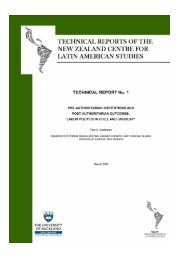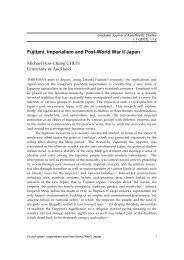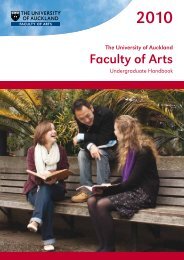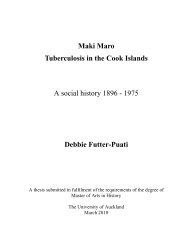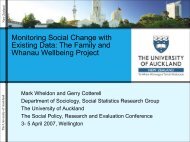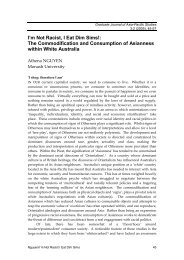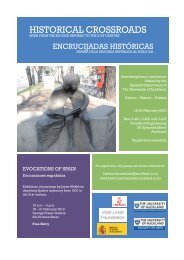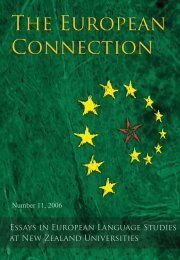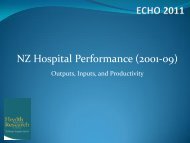Multiplying and Dividing - The University of Auckland
Multiplying and Dividing - The University of Auckland
Multiplying and Dividing - The University of Auckland
Create successful ePaper yourself
Turn your PDF publications into a flip-book with our unique Google optimized e-Paper software.
Chapter 13A Political Ecological Perspective on Housing Conditions <strong>and</strong>Tuberculosis Transmission among Māori in Two Different GeographicalAreas during the Early- <strong>and</strong> Mid-20th CenturyCatherine FinnRates <strong>of</strong> tuberculosis among Māori are currently, <strong>and</strong> have historically been, eight to ten timesthose <strong>of</strong> Pākehā (Lange 1999:30, Turnbull 2002:8). In 1936, the age-sex st<strong>and</strong>ardised rate <strong>of</strong>tuberculosis mortality for Māori was 50.4 per 10,000 people, as compared with the Pākehārate <strong>of</strong> 5.3 (Finn 2007:45). Tuberculosis mortality was responsible for between 17.2 <strong>and</strong>25.9% <strong>of</strong> total Māori deaths between 1918 <strong>and</strong> 1945. This is in comparison to the Pākehāsituation, in which tuberculosis deaths made up between 3.7 <strong>and</strong> 7.4% <strong>of</strong> total Pākehā deathsduring this time period (Finn 2007:46).<strong>The</strong> links between tuberculosis, marginalisation <strong>and</strong> subst<strong>and</strong>ard housing are well established(see Farmer 1997a:347, Leon 2001:69-70, Acevedo-Garcia 2000, <strong>and</strong> Drucker et al. 1994).Because Māori have experienced the ill-effects <strong>of</strong> colonisation, it is likely that the differencein rates between Māori <strong>and</strong> Pākehā can be seen as the transposition <strong>of</strong> social inequalities uponthe biologies <strong>of</strong> these two populations (Farmer 1997b:429, Goodman <strong>and</strong> Leatherman 1998:5,Ward 1999:1). <strong>The</strong> relationship between social inequality <strong>and</strong> tuberculosis occurs through anumber <strong>of</strong> pathways, with housing conditions being one. Overcrowded, poorly ventilated <strong>and</strong>dark housing conditions are common among marginalised populations, <strong>and</strong> there is evidencethat housing conditions were more <strong>of</strong>ten subst<strong>and</strong>ard <strong>and</strong> overcrowded among Māori thanamong Pākehā (Department <strong>of</strong> Health Head Office 1957-75, Downey 1946:3-17, Trott1940:8-19, Wang <strong>and</strong> Lin 2000:249).However, while these population-level differences are important <strong>and</strong> are likely to reflectwidespread social inequalities, local level factors were also at play to create differences withinthese populations. Important differences in housing conditions occurred within the Māoripopulation, <strong>and</strong> accounts suggest that the rates <strong>of</strong> tuberculosis also varied between Māoricommunities, households <strong>and</strong> individuals (Allen <strong>and</strong> Phillips 1933:55-56, Boston 1948,Dowling <strong>and</strong> Banks 1943:56, Simpson 1940). My interest in the concept <strong>of</strong> local biologies(Littleton 2007) within the Māori population was sparked by contemporary eye-witnessdescriptions by medical students doing their final year dissertations in the Rotorua region inthe North Isl<strong>and</strong> <strong>of</strong> New Zeal<strong>and</strong> in the 1940s (Figure 1) (see Dowling <strong>and</strong> Banks 1943,Simpson 1940). <strong>The</strong>y contrasted the health <strong>and</strong> housing conditions <strong>of</strong> Māori living in thepredominantly rural area surrounding the urban centre <strong>of</strong> Rotorua city, with two kāinga(Māori-style settlements) 1 , Whakarewarewa <strong>and</strong> Ohinemutu, within Rotorua city (Figure 2).<strong>The</strong> authors <strong>of</strong> these studies concluded that the health <strong>of</strong> the kāinga residents in the urbancentre was better than that <strong>of</strong> their rural neighbours. Simpson (1940) based his analysis onnumbers <strong>of</strong> Māori from the two areas who were hospitalised for various diseases, <strong>and</strong> foundthat a higher proportion <strong>of</strong> those Māori hospitalised for TB came from the surrounding ruralarea. For instance, he found that in 1936, 83% <strong>of</strong> Māori hospitalised for TB came from thesurrounding rural area (Simpson 1940). While his conclusions would not be seen asconclusive today - we would need rates <strong>and</strong> age-st<strong>and</strong>ardised ones at that - it seems likely thatSimpson was seeing a difference, as his data was not just based on cases, but on otherobservations <strong>and</strong> discussions with very well-informed district health nurses. Further supportfor this difference is also supplied by a slightly later dissertation. Dowling <strong>and</strong> Banks (1943)examined 15 schoolchildren from Whakarewarewa who had tested positive in the Mantoux163




